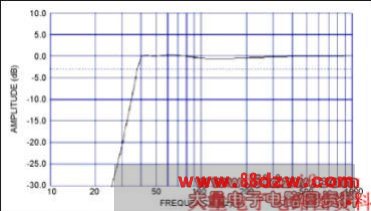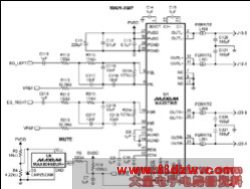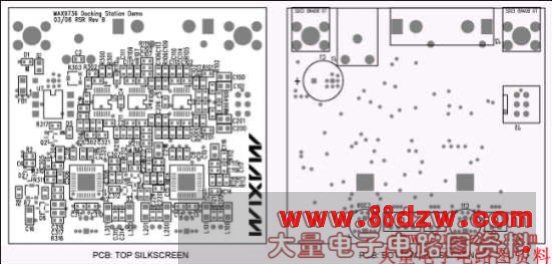Reference Design for a Class-D
[11-20 17:32:34] 来源:http://www.88dzw.com 模拟电子技术 阅读:8343次
文章摘要:DD and D1 is set to light blue when power is attached.A simple reset circuit (through U6) is used to create a mute signal on power-up and power-down for both amplifier chips. This step avoids output transient noises due to input circuitry settling. The mute control threshold is programmed to approxi
Reference Design for a Class-D,标签:模拟电子技术基础,模拟电子电路,http://www.88dzw.comDD and D1 is set to light blue when power is attached.
A simple reset circuit (through U6) is used to create a mute signal on power-up and power-down for both amplifier chips. This step avoids output transient noises due to input circuitry settling. The mute control threshold is programmed to approximately 10V with the R3 and R4 resistor-divider.
The MAX9736 features a patented filter-less modulation method which eliminates the need for bulky inductor-based filters. Only simple ferrite beads (L100 to L301) are required at the output.
Speakers and Physical Enclosure
The loudspeaker used for the subwoofer is a 5in-diameter model from Tymphany, part 830945, with a 4Ω nominal impedance and a resonance frequency of 47.4Hz. The 2in loudspeakers used for the left and right channels are model 830970, also from Tymphany. These loudspeakers have 4Ω nominal impedance and a resonance frequency of 147.5Hz.
A low f3 of 35Hz is targeted for the acoustic system, so a sixth-order alignment is used. That alignment includes a second-order highpass filter within the active crossover. The overall system is housed in a single box enclosure with the three loudspeakers, tuned port, and circuit PCB. The subwoofer is mounted as down-firing to minimize the box size and to help increase efficiency by compression loading. The resulting box volume is approximately 3.79l and the vented port is tuned to 54Hz. The outside overall box dimensions are approximately 355mm x 180mm x 120mm. The speaker crossover equalization is designed as a fourth-order Linkwitz-Riley at 250Hz; the speaker equalization for the satellites consists of a parametric EQ with f = 500Hz, gain = +6dB, Q = 0.5, and a shelving filter with f3 = 3.8kHz and a gain of +5.8dB. Figure 3 shows the system's response.
Figure 3. Total system simulated response shows maximally flat down to 40Hz.
The mechanical drawings included in this document are copies of those used to construct the prototype model. The prototype was built using 1/4in clear acrylic plastic and assembled with drilled/tapped screws and acrylic adhesive. A consumer product version might be constructed using a more cost-effective material such as wood, MDF, ABS, etc.
Circuit Schematics

More detailed image (PDF, 80.4kB)
More detailed image (PDF, 84.4kB)
More detailed image (PDF, 92kB)
PCB Layout

《Reference Design for a Class-D》相关文章
- › Reference Voltage for Multiple
- › Understanding Voltage-Referenc
- › Reference Design for a Class-D
- › 确保打印头电源动态输出电压的参考设计,Reference D
- 在百度中搜索相关文章:Reference Design for a Class-D
- 在谷歌中搜索相关文章:Reference Design for a Class-D
- 在soso中搜索相关文章:Reference Design for a Class-D
- 在搜狗中搜索相关文章:Reference Design for a Class-D




 当前位置:
当前位置: